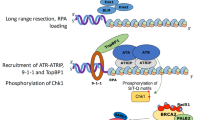Abstract
The sequential staining with distamycin A/DAPI provides an ideal method for studying the behaviour of heterochromatic regions in human male meiosis. The various meiotic and postmeiotic stages were found to have different staining qualities. Although all heterochromatic regions in human pachytene cells show specific DA/DAPI fluorescence, bright and clearly stained heterochromatic blocks can be distinguished from small DA/DAPI spots. Pachytene nuclei exhibit associations between heterochromatic regions of non-homologous bivalents. The heterochromatin of bivalent 9 generally presents as a cluster of small, discrete bodies. The heterochromatic regions of chromosomes 1, 9, 15, 16 and Y are preferentially stained at diakinesis and metaphase of the second meiotic division. The specific DA/DAPI staining disappears with the progressive volume reduction of middle and late spermatid nuclei. The heterochromatin of the chromatids fuses to form a large chromocenter during spermatid differentiation.
Similar content being viewed by others
References
Barr, H. J. & Ellison, J. R., 1972. Ectopic pairing of chromosome regions containing chemically similar DNA. Chromosoma 39: 53–61.
Buckton, K. E., Spowart, G., Newton, M. S. & Evans, H. J., 1985. Forty four probands with an additional ‘marker’ chromosome. Hum. Genet. 69: 353–370.
Buhariwalla, F. & Blecher, S. R., 1983. A rapid DAPI-distamycin method for identification of the mouse Y chromosome. Cytogenet. Cell Genet. 35: 78–79.
Burgoyne, P. S., 1982. Genetic homology and crossing over in the X and Y chromosomes of mammals. Hum. Genet. 61: 85–90.
Chandley, A. C., Edmond, P., Christie, S., Gowans, L., Fletcher, J., Frackiewicz, A. & Newton, M., 1975. Cytogenetics and infertility in man. I. Karyotype and seminal analysis. Ann. hum. Genet. 39: 231–254.
Chen, A. T. L. & Falek, A., 1971. Cytological evidence for the association of the short arms of the X and Y chromosomes in the human male. Nature 232: 555–556.
Driscoll, D. J., Palmer, C. G. & Melman, A., 1979. Nonhomologous associations of C-heterochromatin at human male meiotic prophase. Cytogenet. Cell Genet. 23: 23–32.
Hsu, T. C., Cooper, J. E. K., Mace, M. L. & Brinkley, B. R., 1971. Arrangement of centromeres in mouse cells. Chromosoma 34: 73–87.
Hungerford, D. A., 1972. Pachytene maps of normal human chromosomes and an example of their application in the study of cytogenetic abnormalities. In: Perspectives in cytogenetics. (Eds S. W.Wright, B. F.Crandell & L.Boyer), pp. 187–195, Charles C. Thomas, Springfield, Illinois, USA.
Leibundgut, B., Müller, H., Haller, M. H. & DaRugna, D., 1979. Bedeutung der Meiose-Untersuchung bei männlicher Infertilität. Schweiz. med. Wschr. 109: 1600–1609.
Luciani, J. M., Devictor, M., Morazzani, M. R. & Stahl, A., 1977. Pachytene mapping of the C 9 and acrocentric bivalents in the human oocyte. Hum. Genet. 36: 197–204.
Mayr, B., Schnedl, W. & Schleger, W., 1979. Paarungsverhalten der meiotischen Chromosomen beim Rind. Z. Tierzücht. Züchtungsbiol. 95: 112–117.
Mayr, B., Schweizer, D. & Schleger, W., 1983. Characterization of the canine karyotype by counterstain-enhanced chromosome banding. Can. J. Genet. Cytol. 25: 616–621.
Meredith, R., 1969. A simple method for preparing meiotic chromosomes from mammalian testis. Chromosoma 26: 254–258.
Page, B., 1973. Identification of chromosome 9 in human male meiosis. Cytogenet. Cell Genet. 12: 254–263.
Palmer, C. G., Yu, P. L., Wang, L. Y., Merritt, A. D., Conneally, P. M., Magenis, R. E. & Rivas, M. L., 1977. Segregation and assortment of C-band variants of chromosome 1, 9, 16. J. supramol. Struct. Suppl. 1: 113.
Pathak, S., 1983. The behaviour of X chromosomes during mitosis and meiosis. In: Cytogenetics of the mammalian X chromosome, Part A: Basic mechanisms of X chromosome behaviour. (Ed. A. A.Sandberg), pp. 67–106, Alan R. Liss, New York.
Pfeiffer, R. A., 1974. Cell cultures from blood and bone marrow. In: Methods in human cytogenetics (Eds H. G.Schwarzacher & U.Wolf), pp. 1–37, Springer, Berlin.
Robinson, J. A., Buckton, K. E., Spowart, G., Newton, M., Jacobs, P. A., Evans, H. J. & Hill, R., 1976. The segregation of human chromosome polymorphisms. Ann. Hum. Genet. 40: 113–122.
Schmid, M. & Haaf, T., 1984. Distamycin A/DAPI bands and the effects of 5-azacytidine on the chromosomes of the chimpanzee, Pan troglodytes. Cytogenet. Cell Genet. 38: 192–199.
Schmid, M., Solleder, E. & Haaf, T., 1984. The chromosomes of Micromys minutus (Rodentia, Murinae). I. Banding analysis. Cytogenet. Cell Genet. 38: 221–226.
Schmid, M., Haaf, T., Ott, G., Scheres, J. M. J. C. & Wensing, J. A. B., 1986. Heterochromatin in the chromosomes of the gorilla: analyses with distamycin A/DAPI, D287/170, chromomycin A3, quinacrine and 5-azacytidine. Cytogenet. Cell Genet. 41: 71–82.
Schnedl, W., Abraham, R., Förster, M. & Schweizer, D., 1981. Differential fluorescent staining of porcine heterochromatin by chromomycin A3/distamycin A/DAPI and D287/170. Cytogenet. Cell Genet. 31: 249–253.
Schwarzacher, H. G., 1974. Preparation of metaphase chromosomes. In: Methods in human cytogenetics. (Eds H. G.Schwarzacher & U.Wolf), pp. 71–81, Springer, Berlin.
Schwarzacher, T., Mayr, B. & Schweizer, D., 1984. Heterochromatin and nucleolus-organizer-region behaviour at male pachytene of Sus scrofa domestica. Chromosoma 91: 12–19.
Schweizer, D., Ambros, P. & Andrle, M., 1978. Modification of DAPI banding on human chromosomes by prestaining with a DNA binding oligopeptide antibiotic, distamycin A. Expl Cell Res. 111: 327–332.
Schweizer, D., Ambros, P., Andrle, M., Rett, A. & Fiedler, W., 1979. Demonstration of specific heterochromatic segments in the orangutan (Pongo pygmaeus) by a distamycin A/DAPI double staining technique. Cytogenet. Cell Genet. 24: 7–14.
Schweizer, D., 1981. Counterstain-enhanced chromosome banding. Hum. Genet. 57: 1–14.
Author information
Authors and Affiliations
Rights and permissions
About this article
Cite this article
Haaf, T., Müller, H. & Schmid, M. Distamycin A/DAPI staining of heterochromatin in male meiosis of man. Genetica 70, 179–185 (1986). https://doi.org/10.1007/BF00122184
Received:
Accepted:
Issue Date:
DOI: https://doi.org/10.1007/BF00122184




